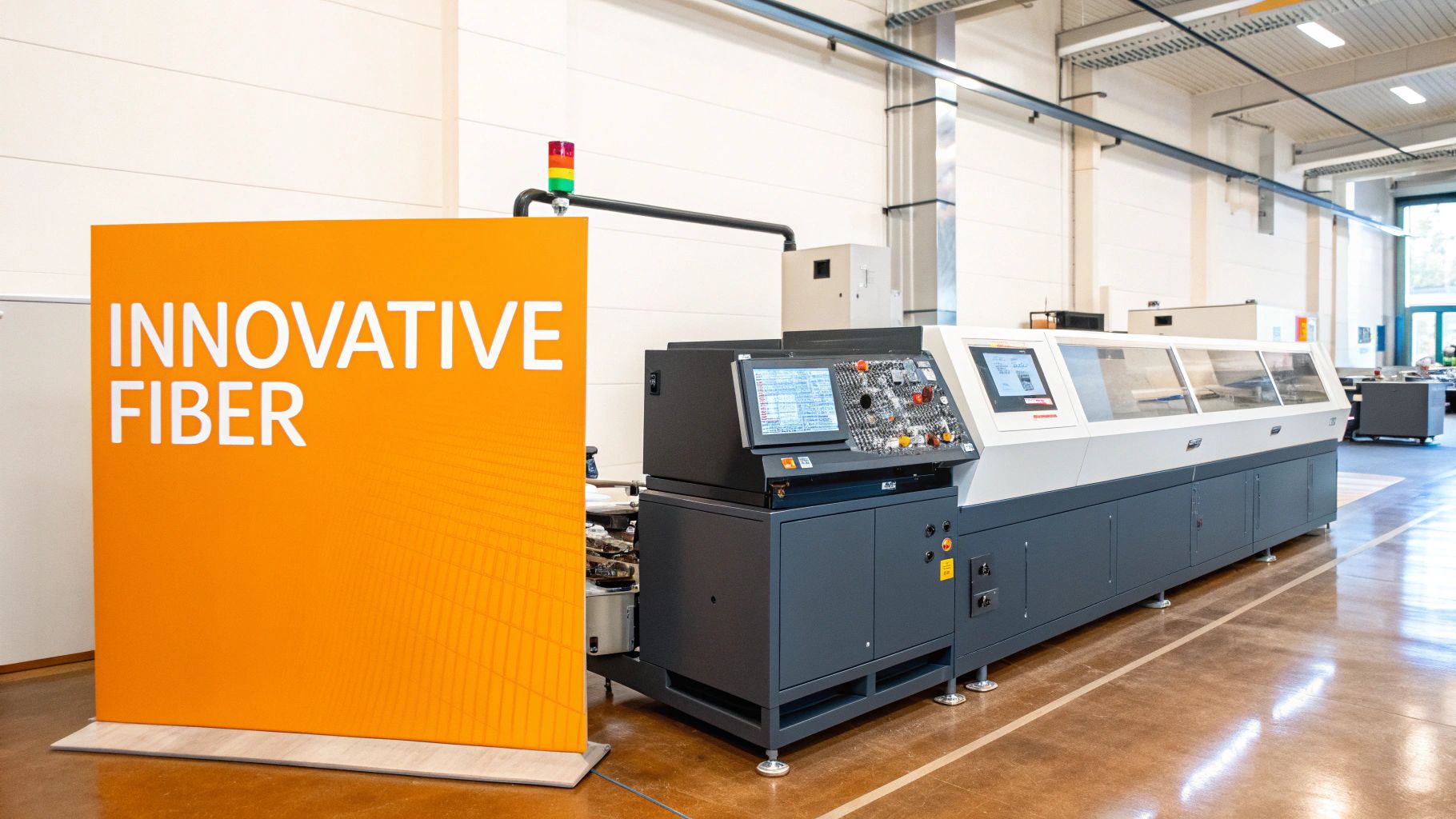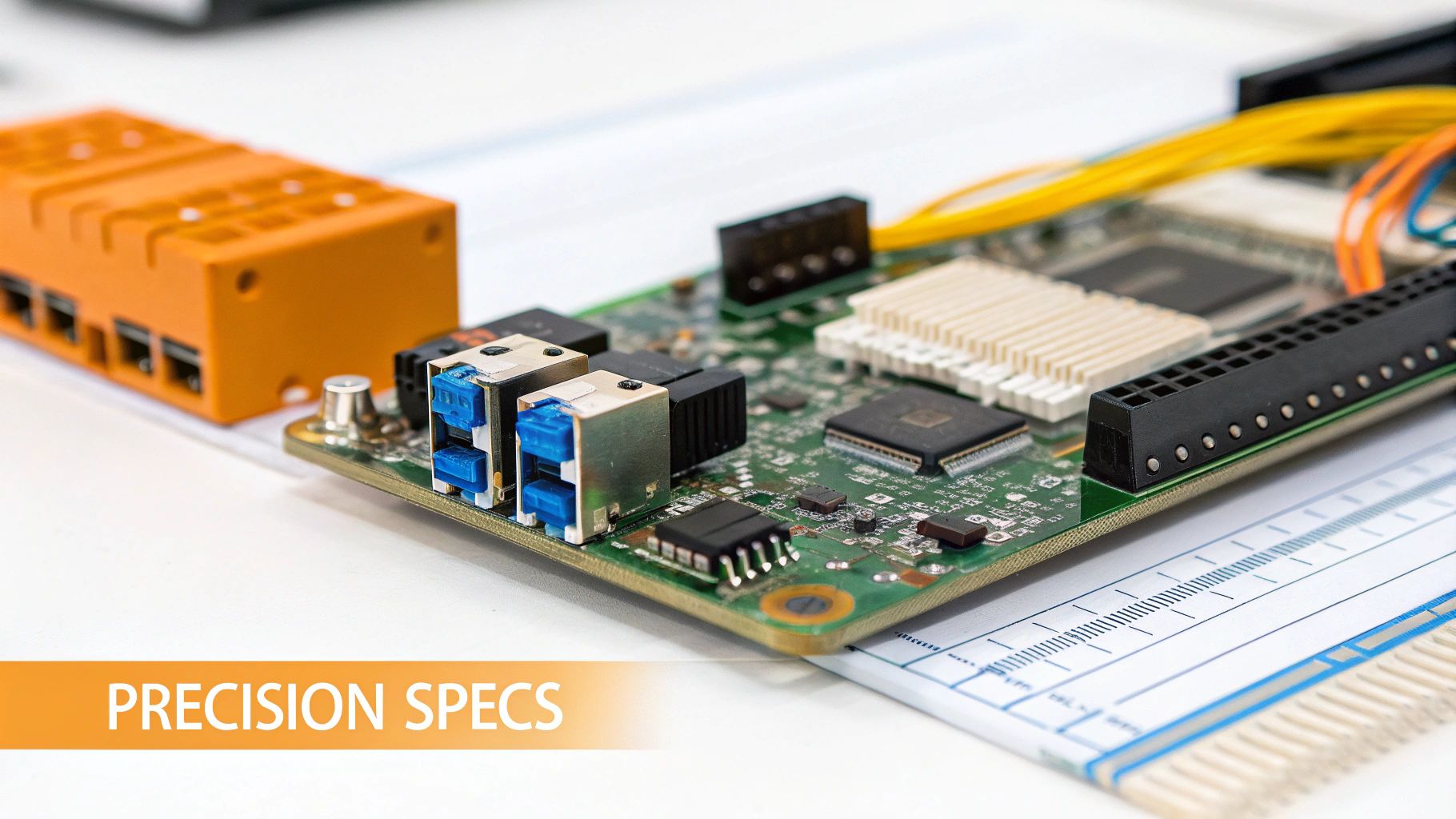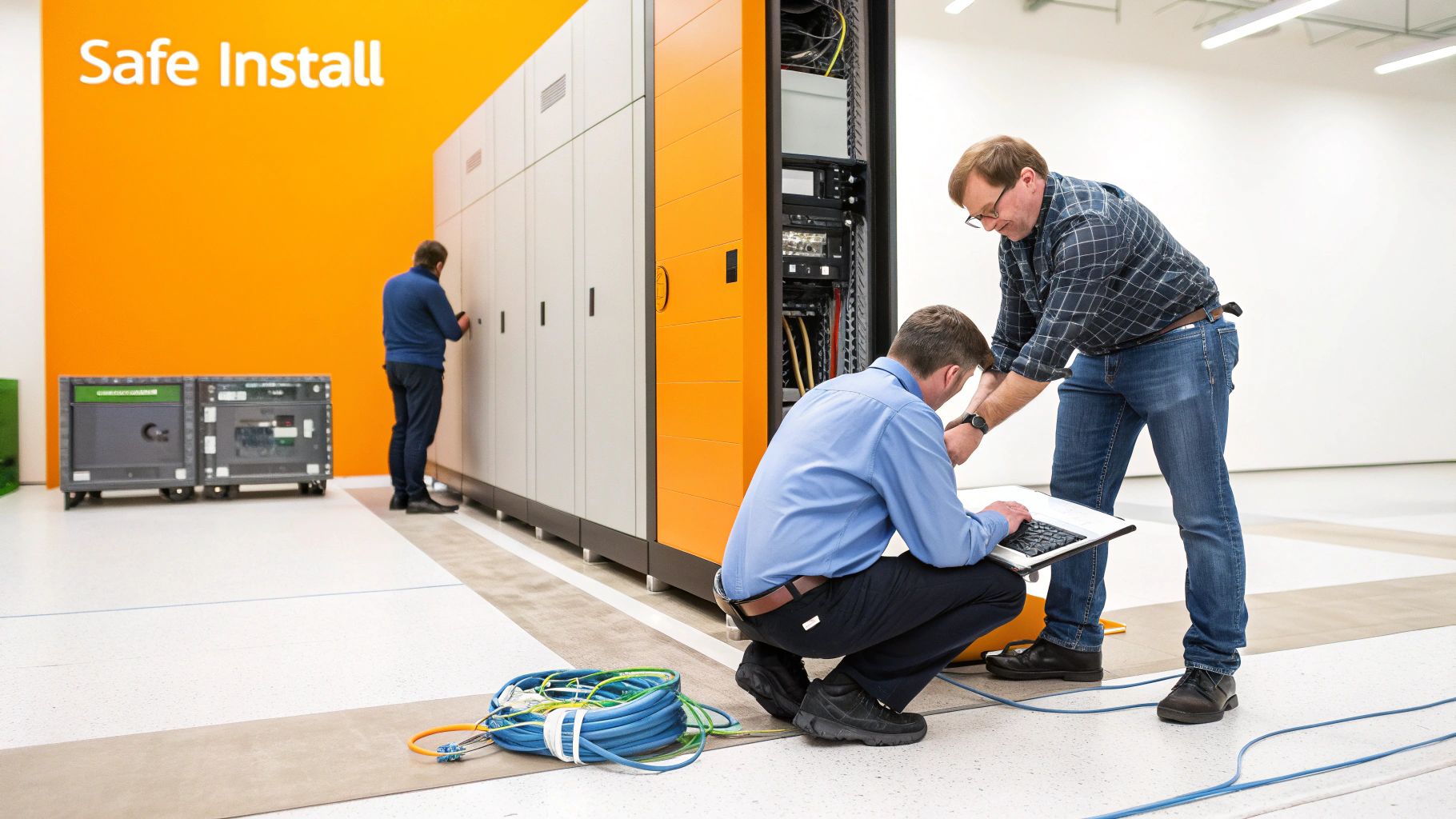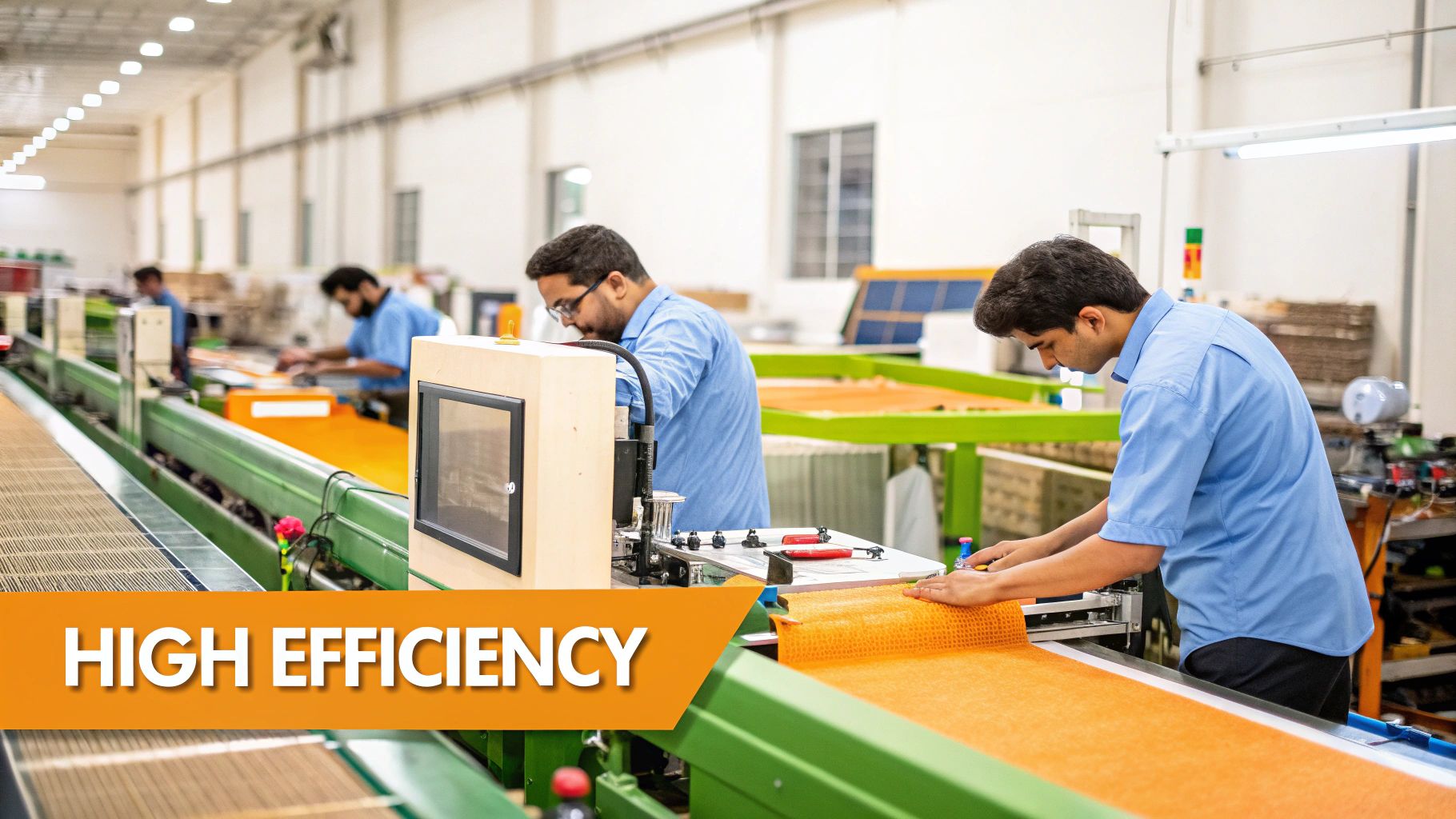The Technology Behind Trumpf TRU MATIC Fiber Conversion
The Trumpf TRU MATIC fiber conversion offers a significant upgrade to laser cutting. This process replaces the older CO2 laser in a TRU MATIC machine with a modern fiber laser. This seemingly minor change creates several advantages, thanks to the fundamental differences between the two laser types. For instance, CO2 lasers use a complex series of mirrors and lenses to direct the beam. Fiber lasers, on the other hand, transmit light through a flexible optical fiber. This simpler delivery system results in higher efficiency and reduced maintenance.
Understanding Fiber Laser Advantages
A key advantage of fiber lasers is their superior beam quality. The highly focused and concentrated beam delivers significantly higher power density where it cuts. This leads to faster cutting speeds, especially with thinner materials. Plus, the higher power density produces cleaner cuts with a smaller heat-affected zone (HAZ), minimizing distortion and improving the final product. This precision also allows for processing a wider variety of materials.
The improved efficiency of fiber lasers is another major benefit. Fiber lasers convert a much greater percentage of input power into usable laser power than CO2 lasers. This results in lower energy consumption, reducing both operational costs and environmental impact. Trumpf has long been a leader in laser technology, demonstrating consistent financial growth. In the 2022/23 fiscal year, Trumpf’s revenue jumped by 27% to €5.4 billion, largely due to advancements in fiber laser solutions. More detailed statistics are available. This strong financial performance highlights the broad adoption of this technology.
Integrating With Existing Machinery
The TRU MATIC fiber conversion integrates smoothly with your existing TRU MATIC machine. This protects your initial investment while substantially upgrading your capabilities. The conversion process generally involves replacing the laser source, beam delivery system, and control software. The core mechanics of the machine, however, stay the same. This allows operators already familiar with the TRU MATIC platform to quickly adapt to the fiber laser system.
You might be interested in: How to master...

This approach minimizes downtime and production disruptions, letting you quickly benefit from fiber laser technology. The conversion effectively modernizes your existing equipment, making it more competitive in demanding manufacturing environments. This makes the Trumpf TRU MATIC fiber conversion an attractive choice for businesses wanting to improve cutting performance, increase efficiency, and expand material processing options.
Unleashing Production Speed: The Real-World Impact
The Trumpf TRUFiber laser conversion offers more than just hypothetical improvements; it delivers tangible, real-world results. Manufacturers who have adopted this technology are seeing substantial changes in their daily operations, primarily due to a significant increase in processing speed. This speed boost isn't material- or thickness-specific; it applies across the board.
Faster Processing, Increased Throughput
For thinner materials, the speed increase can be an impressive 300%. Imagine finishing jobs in a fraction of the time it previously took. This enhanced throughput eliminates production bottlenecks and allows for faster turnaround times for customer orders. A job that once required three hours might now be completed in just one.
This increased efficiency directly translates to higher profitability and the capacity to handle a larger volume of work. Furthermore, the smaller heat-affected zone (HAZ) associated with fiber laser cutting contributes to faster secondary operations. With less heat applied to the surrounding material, parts cool down more rapidly, requiring less finishing.
Reduced Downtime, Enhanced Reliability
Fiber laser systems, known for their reliability, require significantly less maintenance than their CO2 counterparts. This translates to reduced downtime and more predictable production schedules. The simplified beam delivery system in a fiber laser, for instance, eliminates the need for frequent mirror alignments and cleaning, a routine maintenance task with CO2 lasers.
This contributes to greater operational efficiency. Trumpf's dedication to automation and efficiency is evident in the productivity improvements seen in their laser cutting machines. The TruLaser Series 3000, as an example, can process components three times faster with the TruDisk 24001 laser. This enhances table throughput by up to 80%, depending on the material being processed.
These productivity gains are integral to the TRUFiber conversion, improving both cutting speed and the final quality of the cut parts. Features like BrightLine fiber and CoolLine further enhance efficiency for demanding industrial applications, including the processing of mild steel up to 50 mm thick.
To illustrate the benefits of converting to a fiber laser system, let's examine a comparison of key performance metrics:
The following table compares key performance metrics before and after a fiber conversion.
Productivity Comparison: Before and After Fiber Conversion
| Performance Metric | Traditional CO2 System | Fiber-Converted System | Improvement Percentage |
|---|---|---|---|
| Cutting Speed (Mild Steel, 1mm) | 100 inches/min | 400 inches/min | 300% |
| Throughput (Parts per hour) | 50 | 150 | 200% |
| Downtime (hours per month) | 8 | 2 | 75% |
| HAZ (mm) | 0.5 | 0.1 | 80% |
This table highlights the significant improvements achieved across various performance indicators after implementing a fiber laser system. The most dramatic improvement is seen in cutting speed, followed by throughput. Downtime and HAZ are also substantially reduced.
Automation Amplifies Productivity
The Trumpf TRUFiber conversion is further enhanced by automated features like smart nozzle changers and condition monitoring. Smart nozzle changers automatically choose the appropriate nozzle for each specific job, eliminating manual intervention and reducing setup times. Condition monitoring systems constantly track the laser's performance, alerting operators to potential issues before they escalate into major problems.
This proactive approach minimizes unforeseen downtime and extends the operational lifespan of the laser. These combined benefits empower manufacturers to handle urgent orders and complex jobs with exceptional efficiency and reliability.
Making Sense of Your Investment: ROI and Cost Analysis
When considering a TRUMPF TRU MATIC fiber conversion, understanding the financial implications is key. Let's explore the costs and potential returns to see if this upgrade makes sense for your business. This analysis will cover initial investment needs, operating cost reductions, and potential revenue increases.
Initial Investment and Financing
The initial investment for a TRUMPF TRU MATIC fiber conversion depends on the specific machine model and necessary upgrades. However, it's more than a one-time expense. It’s a strategic investment in your company’s future. Many manufacturers offset the initial cost through financing, such as leasing or a phased implementation. A phased approach lets you convert some of your equipment at a time, which helps manage cash flow.
Operational Cost Reductions: Energy and Maintenance
A major advantage of fiber laser technology is its energy efficiency. TRUMPF TRU MATIC fiber conversions usually reduce energy consumption by 50-70%. This leads to lower monthly utility bills – a significant savings that adds up. Maintenance costs also drop considerably. Fiber lasers have fewer moving parts than CO2 lasers, reducing wear and tear and the need for frequent part replacements. This means less downtime for repairs and lower overall maintenance expenses.
TRUMPF's success with TRU MATIC fiber conversion stems from their focus on modular, cost-effective solutions. Machines like the TruPunch 1000 and TruMatic 1000 fiber are prime examples. These models have a compact footprint with automated part sorting and ejection, making them ideal for businesses starting or expanding sheet metal operations. The TruMatic 1000 fiber's energy efficiency, saving up to 65% energy compared to hydraulic systems, is a major benefit. Learn more about these machines here.

Revenue Generation Potential
Besides cost savings, the TRUMPF TRU MATIC fiber conversion creates new revenue opportunities. The increased speed and precision of fiber lasers allow you to handle more complex, higher-margin jobs. This attracts new clients and improves service for existing ones. Faster processing also increases your overall production capacity, leading to higher potential output and revenue.
Calculating Your ROI
The return on investment (ROI) for a TRUMPF TRU MATIC fiber conversion depends on several factors: production mix, material types, and throughput requirements. Manufacturers typically see a return on their investment within 12-24 months.
To estimate the ROI for your specific situation, let's look at a simplified cost analysis.
The following table shows a cost analysis and return on investment breakdown for a typical TRUMPF TRU MATIC fiber conversion.
Cost Analysis and Return on Investment Breakdown
| Cost/Benefit Category | Initial Investment | Annual Savings | Payback Period |
|---|---|---|---|
| Laser Source Upgrade | $50,000 | - | - |
| Installation & Training | $10,000 | - | - |
| Energy Savings | - | $15,000 | - |
| Maintenance Savings | - | $5,000 | - |
| Increased Throughput (estimated) | - | $20,000 | - |
| Total | $60,000 | $40,000 | 18 Months (approx.) |
This table provides a simplified example. Actual figures will vary based on your specific circumstances. A detailed analysis of your current production and projected improvements is crucial for accurate ROI potential. A TRUMPF representative can offer insights and help develop a personalized financial model.
Navigating the Implementation Process Step by Step

Successfully converting your Trumpf TRU MATIC to fiber laser technology requires a well-structured approach. This section provides a step-by-step guide, drawing from the experiences of manufacturers who've already made the switch. Following these steps can help minimize disruption and maximize the benefits of your new system.
Assessing Your Current Setup
Begin by thoroughly evaluating your current TRU MATIC machine and its place within your workflow. Document its current condition, typical applications, and the materials you process. Also, note any existing issues, like mechanical wear or outdated software, that could impact the conversion. This initial assessment provides a crucial benchmark for measuring improvements after the conversion.
Preparing Your Facility
Next, prepare your facility for the upgrade. This might involve ensuring adequate space for the technicians, confirming access to sufficient power and cooling, and possibly adjusting existing material handling systems. For instance, you might need to modify conveyor belts or robotic arms to accommodate the fiber laser's increased speed. Proper preparation minimizes downtime and ensures a smooth transition.
Training Your Team
Operator training is essential for unlocking the full potential of your new fiber laser system. While experienced TRU MATIC operators will likely adapt quickly, dedicated training on the specifics of fiber laser technology is key. This includes software operation and maintenance procedures. Thorough training empowers your team to utilize the new capabilities effectively and optimize machine performance.
Addressing Implementation Challenges
Expect some implementation challenges. Common hurdles include scheduling conflicts, integrating the upgraded TRU MATIC into existing workflows, and troubleshooting unexpected technical glitches. Proactive planning and open communication with the installation team can mitigate many of these issues. For further insights, you might find this resource helpful: How to master...
Creating a Conversion Timeline
Develop a detailed timeline outlining each stage of the conversion. Include the assessment, preparation, installation, training, and testing phases. This timeline acts as a roadmap for the project, keeping everyone aligned and facilitating coordination with other production activities. It also helps minimize disruptions and ensures a timely return to full operation.
Checklists for Each Phase
Use checklists for every phase of the Trumpf TRU MATIC fiber conversion. This meticulous approach helps avoid overlooking critical steps and ensures a comprehensive approach. A well-defined checklist allows you to effectively track progress and verify that all necessary tasks are completed before moving on.
Minimizing Production Disruption
Minimizing production downtime is crucial during the conversion. Strategically schedule the installation and training to minimize interference with ongoing production. Also, develop a contingency plan for unexpected delays or technical difficulties. This proactive approach helps maintain customer satisfaction and limit potential revenue loss.
Maximizing Competitive Advantage
The Trumpf TRU MATIC fiber conversion offers a substantial competitive edge. With improved speed, precision, and material processing capabilities, you can provide higher quality products, faster turnaround times, and potentially lower prices. This enhanced competitiveness strengthens your market position and sets the stage for continued growth.
Expanding Your Material Processing Capabilities

A Trumpf TRU MATIC fiber conversion doesn't just improve existing processes; it unlocks a whole new range of material processing options. This expanded capability allows you to work efficiently with materials that were previously challenging or even impossible to process with a CO2 laser. This includes reflective metals such as copper and brass, as well as other specialized alloys.
Why Fiber Lasers Excel With Diverse Materials
The secret to this expanded material compatibility lies in the unique characteristics of a fiber laser beam. Fiber lasers generate a highly focused beam with a significantly shorter wavelength than CO2 lasers. This results in better absorption by reflective materials, which have historically been problematic for CO2 laser systems. The concentrated energy delivery also minimizes heat input. This leads to cleaner cuts and reduces distortion, which is especially important for intricate or delicate parts.
Think about cutting thin sheets of copper, for example. With a CO2 laser, the reflected energy can damage the machine or result in inconsistent cuts. A fiber laser, on the other hand, cuts copper cleanly, precisely, and quickly. This ability to process reflective metals opens up applications in electronics, jewelry making, and various other specialized fields.
Optimizing Cutting Parameters for Different Materials
Working with a wider range of materials requires understanding and adjusting the cutting parameters. Each material reacts differently to laser energy. This means factors like power, speed, and assist gas pressure must be optimized for each material and its thickness. Thankfully, modern TRU MATIC control software simplifies this task. Many systems offer pre-programmed settings for common materials, along with tools to fine-tune parameters for specific requirements.
Material thickness also plays a crucial role. Fiber lasers excel at cutting thin materials, but they are also highly effective with thicker stock. The high power density allows for efficient cutting of thicker materials, though parameter adjustments are needed compared to thinner gauges. This versatility across various thicknesses makes a Trumpf TRU MATIC fiber conversion a truly adaptable solution for diverse manufacturing demands.
New Revenue Streams and High-Margin Applications
This broadened material capability opens doors to new revenue streams and improved profit margins. The ability to process materials that competitors may struggle with provides a competitive advantage. This can lead to high-value projects and access to specialized markets.
For instance, consider medical device manufacturing, where precise cutting of complex components from biocompatible alloys is crucial. The aerospace industry also demands precise cutting of lightweight, high-strength materials with strict tolerances. These are just two examples of the high-margin opportunities available with a Trumpf TRU MATIC fiber conversion.
Developing New Products and Services
Finally, consider the potential for developing entirely new products and services. The expanded material processing capabilities allow you to explore designs and manufacturing processes that were previously impossible. This could involve creating innovative products using the unique properties of new materials or offering specialized fabrication services to niche markets. By embracing the full potential of fiber laser technology, you can improve your existing operations and position your business for lasting growth and success in a dynamic manufacturing environment.
Future-Proofing Your Manufacturing Operations
A Trumpf TRU MATIC fiber conversion offers more than just immediate boosts to your bottom line. It sets the stage for lasting success by aligning your business with the evolving landscape of manufacturing. This includes adapting to the demands of Industry 4.0 and prioritizing sustainability.
Embracing Industry 4.0
Fiber-converted systems provide a robust foundation for advanced automation. This encompasses automated material handling, lights-out manufacturing, and predictive maintenance.
Automated material handling minimizes manual labor and increases efficiency by seamlessly transferring parts between processes. This streamlines workflow and reduces errors.
Lights-out manufacturing, enabled by dependable automated systems, permits continuous production around the clock. This increases capacity without adding shifts.
Predictive maintenance, powered by data from connected fiber systems, anticipates equipment failures. This allows for proactive maintenance, minimizing downtime and optimizing performance. You might find helpful information in these additional resources related to the laser industry.
Meeting Sustainability Goals
Environmentally responsible practices are a core business value today. Reduced energy consumption and minimized material waste are key aspects of these initiatives. Trumpf TRU MATIC fiber conversion contributes significantly to both.
Fiber lasers use considerably less energy than traditional CO2 lasers. This reduces operating expenses and shrinks your carbon footprint.
The precision of fiber lasers also minimizes waste. Tighter, more controlled cuts mean less scrap and better material usage. This saves money and lessens the environmental impact of your operations. These combined environmental and economic advantages make fiber conversion a compelling option for sustainability-focused manufacturers.
Leveraging Digital Connectivity for Agility
Leading manufacturers leverage the digital connectivity of fiber systems to gain valuable process insights. This data enables workflow optimization and agile responses to market changes. Imagine accessing real-time data on machine performance, material usage, and output.
This data-driven approach identifies areas for improvement, refines processes, and informs decisions about resource allocation. This agility allows manufacturers to adapt to evolving customer needs and market fluctuations, giving them a competitive edge. For instance, real-time data can reveal bottlenecks in production. Addressing these boosts efficiency and shortens lead times. The ability to respond swiftly to changes in customer orders or material availability becomes a significant advantage.
Achieving Long-Term Success With Fiber Conversion
Adopting a Trumpf TRU MATIC fiber conversion delivers both immediate productivity gains and long-term positioning for sustained growth. The combination of advanced automation, sustainability features, and data-driven insights creates a powerful platform for the future. This forward-thinking approach empowers manufacturers to adopt new technologies, respond to market dynamics, and stay competitive in a demanding global market.
Ready to take your manufacturing to the next level? Explore the Trumpf TRU MATIC fiber conversion and see how it can transform your business at Laser Insights China.

